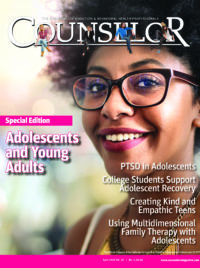Share
Residential treatment has typically been the recommended intervention for youth presenting with the most severe co-occurring substance use and mental health disorders. Residential treatment is commonly indicated for such youth who have not responded to less restrictive treatments, require stabilization, present a danger to themselves or their families, or demonstrate a public safety risk (Drake, O’Neal, & Wallach, 2008; Winters, Tanner-Smith, Bresani, & Meyers, 2014). Though residential treatment is the conventional recommendation for this population, firm conclusions on its effectiveness are not possible because there are few rigorous studies comparing residential treatment to community-based alternatives.
What do we know about residential treatment from the exiting research? First, it is often more costly that treating youth while they remain in their homes and communities. Second, research suggests that residential treatment shows diminishing effects following discharge. These findings—and the disruption to adolescents and families when youth are placed out of their homes—beg the question whether residential treatment is actually the best course of action for certain youth. Even without definitive empirical answers to this question, policy makers in the United States and Europe have begun to utilize intensive outpatient and in-home treatments as alternatives to residential treatment (Heggeness & Davis, 2010). Intensive family-based treatments in particular are being utilized as an alternative to residential treatment due to strong evidence supporting their effectiveness in outpatient settings (Tanner-Smith, Wilson, & Lipsey, 2013; Van der Pol et al., 2017). Research is urgently needed to support this shift.
Multidimensional family therapy (MDFT), a family- and community-based treatment, is among the most effective interventions for adolescent substance use, delinquency, and mental health disorders (Dakof et al., 2015; Henderson, Greenbaum, Dakof, & Liddle, 2010; Liddle, Rowe, Dakof, Henderson, & Greenbaum, 2009; Rigter et al., 2013; Schaub et al., 2014; Van der Pol, Henderson, Hendriks, Schaub, & Rigter, 2018). Given MDFT’s effectiveness in treating adolescent substance use and delinquency in the community, it seems reasonable to suggest that MDFT may be a possible nonresidential alternative for youths with co-occurring mental health disorders referred for residential substance use treatment.
The study reported in this article is an intent-to-treat randomized clinical trial (RCT) that directly addresses the question of whether a nonresidential treatment (i.e., MDFT) may be equally or more effective than residential treatment (RT) for youth with serious co-occcurring substance use and mental health disorders.
We hypothesized two things:
- In the early phase of treatment (defined as the first two months of treatment), youth randomly assigned to RT primarily because they are residing in a controlled environment would show superior outcomes to youth in MDFT (in the community)
- From two to eighteen months from intake, youth receiving MDFT would sustain treatment gains significantly more than youth who received residential treatment
Methods
Youth between the ages of thirteen and eighteen, diagnosed with at least one comorbid psychiatric disorder, known to have failed at least one previous treatment for a substance use disorder, and approved for residential care by the State of Florida Department of Children of Families (DCF), the primary payer of residential care in Florida, were randomized to either MDFT or RT. MDFT and RT were administered by two separate DCF-licensed provider organizations. Both treatments were delivered over a six- to nine-month period by a multidisciplinary team, including a case manager in MDFT and milieu staff in RT. All adolescents met with the same board-certified psychiatrist, who conducted an initial evaluation and diagnosis according to DSM-5 criteria (APA, 2013). Any adolescents needing ongoing psychiatric care or medication management during the study continued to see this same psychiatrist.
Interventions
Residential Substance Use Treatment
Particular care was given to site selection. We chose a residential program that was representative of contemporary programs, utilized evidence-based practices, and was well-established as a reputable provider in Miami-Dade County. The residential treatment was based on a social-learning approach that emphasizes positive reinforcement for appropriate coping and other behaviors; accountability; and the development of coping, emotional regulation, drug refusal, and social skills. It integrates cogntive behavioral therapy (CBT) and motivational interviewing (MI) into the daily program. While in treatment—and away from their home and community—youth participated in individual and group therapy, psychiatric services as needed, vocational training, education, and recreational therapy in a structured environment that was both nurturing and challenging. Family members took part in an assessment and planning session at the beginning of treatment, were regularly informed of their children’s progress, and were offered monthly support groups for parents.
Multidimensional Family Therapy
In MDFT, therapists individualize treatment for each youth and their families. They work in four treatment domains: adolescent, parent, family, and community. Throughout treatment, therapists meet individually with parents/caregivers (herein after referred to as “parents”), adolescents, and with their families as a whole. Therapists work to build strong relationships with both teens and their parents. With the teens, treatment goals are to enhance social competence and improve emotional regulation, communication, and coping skills. Therapists also help youth identify positive hopes for the future that can be achieved by discontinuing substance use and delinquency. Treatment goals for the parents include helping them manage their anger and disappointment, increasing behavioral and emotional involvement with their adolescents, reducing their own interparental conflicts, and identifying practical and effective ways to influence their teens. When parents and adolescents have family sessions, with the guidance of their therapists, they work on decreasing conflict, deepening emotional attachments, and improving communication and problem-solving skills. Therapist assistants coordinate with therapists in the community domain by helping families and youth understand and advocate for themselves in important social systems such as juvenile justice and school. The therapist assistants also help to address any barriers to participating in treatment that parents may face, including medical or financial issues.
Both treatments used adherence procedures developed in previous research studies on MDFT and residential treatment (Hogue et al., 1998; Hogue, Dauber, Liddle, & Samuolis, 2004; Holland, 1986). Evaluation of these fidelity measures indicated that both programs delivered their respective treatment in accordance with their prescribed parameters.
Outcome Measures
Primary outcome measures included substance use, frequency of delinquent behaviors, externalizing symptoms, and internalizing symptoms. Participants were evaluated on these measures at intake and at two months to eighteen months after intake.
Efforts were made to keep assessors unaware of which treatment the youth were participating in and the hypotheses of the study. The personal experience inventory (PEI; Winters & Henly, 1989) and the timeline follow-back method (TLFB; Sobell & Sobell, 1992) were used to measure substance abuse. Specifically, we used the PEI personal involvement with chemicals (PIC) scale, a twenty-nine-item scale focusing on psychological and behavioral aspects of substance use and related consequences in the previous thirty days. The PIC demonstrates excellent reliability and validity across diverse adolescent samples (Winters, Latimer, Stinchfield, & Egan, 2004). The TLFB measured youths’ substance consumption (Sobell & Sobell, 1992). The measure has been widely used in drug use treatment studies with both adults and adolescents (Leccese & Waldron, 1994). Youth completed the national youth survey (NYS) self-report delinquency scale (SRD), a well-validated and frequently used instrument (Elliott, Ageton, Huizinga, Knowles, & Canter, 1983) to measure delinquent behaviors. To measure mental health symptoms, adolescents completed the Externalizing and Internalizing subscales of the youth self-report (YSR; Achenbach, 1991). The YSR is a widely used and validated measure of adolescent symptoms and behaviors.
Statistical Analyses
MDFT and RT were compared on the following outcomes:
- Substance use
- Frequency of delinquent behaviors
- Externalizing symptoms (e.g., aggression and violence)
- Internalizing symptoms (depression and anxiety)
Participant change was analyzed using latent growth curve (LGC) modeling (Curren & Hussong, 2003). LGC treats change in outcome as a continuous process, estimating growth parameters in terms of intercepts representing average baseline level, and slopes representing average rate of change over time. Consistent with our hypotheses, we modeled growth trajectories for piece-wise change using two distinct, clinically meaningful trajectories: baseline through two months after baseline (representing change during the early treatment phase), and two months to eighteen months after baseline (representing change during mid- to late treatment and posttreatment).
LGC models using Mplus (Muthén & Muthén, 2010) controlled for adolescent age, gender, and time in treatment by entering these variables as covariates. All randomized participants were included in the analyses regardless of amount of treatment received (i.e., intent-to-treat design).
Youth in the study were at high risk for being placed in a long-term juvenile justice or residential substance use treatment facility at some time during the study assessment window because of the severity of substance use symptoms and delinquency, number of psychiatric diagnoses, and the number of previous substance use treatment placements. McCaffrey, Morral, Ridgeway, and Griffin (2007) caution that behavioral frequency data such as TLFB-assessed substance use and the number of delinquent acts committed as measured by the SRD are subject to selection and suppression effects when placement in a controlled environment such as prison/jail or residential substance use or mental health treatment facility is not considered. Therefore, we treated TLFB and SRD outcomes differently than other outcomes that were less susceptible to such biases (i.e., substance use problem severity as measured by the PEI and externalizing and internalizing symptoms as measured by the YSR). For example, internalizing and externalizing symptoms could be present either in placement or in the community and were analyzed using conventional LGC procedures. For TLFB and SRD outcomes, a latent class pattern mixture model analysis (LCPMM; Morgan-Lopez & Fals-Stewart, 2007) was conducted to control for potentially biased reports of substance use and delinquent behaviors.
Results
Baseline Characteristics
There were no significant differences between the two groups at baseline on demographic characteristics, diagnoses, or pretreatment status on outcome variables. Adolescents who participated in this study were primarily male (75 percent) and Latino (68 percent), with an average age of 15.4 years. They were primarily low income (median family income = $18,771). All youth met criteria for cannabis use disorder, 77 percent for conduct disorder, 71 percent for alcohol use disorder, and 33 percent for stimulant or opioid use disorder. Youth had an average of 3.83 DSM-5 diagnoses at intake. Ninety percent of youth began using substances prior to the age of fifteen. Seventy-one percent had at least one previous residential treatment placement at intake to this study.
Response and Attrition Rates
One-hundered sixty-eight adolescents were screened. Of these, 132 (78 percent) were eligible for the study and 113 consented, yielding an 85 percent response rate (NB: response rates over 70 percent are considered adequate). The study had very little missing data (well over 90 percent completed each assessment), and there was no difference in assessment completion rates between the two treatments (2 (1, N = 113) = 1.83, p = .18).
Identifying the Latent Classes
Results indicated that three latent classes provided the best representation of the placement patterns. The first class, called the “early placement class,” represented 18 percent of participants who showed high probabilities of being placed in a controlled environment—following their original admission in RT if they were originally randomizing assigned to RT—toward the beginning of the follow-up period (between three to nine months from baseline/intake). Eleven percent of the participants, the “late placement class,” like the early placement class, had high probabilities of out-of-home placement, but the placements tended to occur later in the assessment window. The vast majority of youth (72 percent) constituted the third class. This group, the “minimal placement class,” had low probabilities of being in placement during the entire assessment window (i.e., three to eighteen months).
In reporting results for the LCPMM analyses, we focus on the group of adolescents who were less likely to be placed in a controlled environment following treatment (i.e., the minimal placement class) for two reasons:
- The results are less influenced by selection and suppression effects
- The majority of participants (72 percent) were in this class
Outcomes
Phase 1
Contrary to study hypotheses, RT youth did not improve more during early treatment phase than MDFT youth. Youth in both treatments showed statistically significant decreases in substance use problems and frequency, delinquent behaviors, and externalizing and internalizing symptoms. The only treatment difference during this early phase was that youth in MDFT unexpectedly demonstrated a significantly greater decrease in internalizing symptoms (e.g., depression and anxiety) than youth in RT.
Phase 2
We examined the extent to which the treatment gains obtained early in treatment were maintained. We hypothesized that overall MDFT would maintain treatment gains better than RT. Results indicate that, for substance use problems, youth receiving MDFT maintained their treatment gains over time, while youth in RT reported an increase in substance use problems from the early treatment phase. With respect to frequency of substance use (TLFB), youth in the minimum placement class who received MDFT showed significantly less substance use than youth in the minimum placement class who received RT. With respect to frequency of delinquent behaviors, youth in the minimal placement class who received MDFT maintained their earlier treatment gains while youth randomized to RT showed an increase in delinquent behaviors. There were no differences between the two treatment modalities on mental health symptoms: treatment gains were stable in both treatments through eighteen months.
Discussion
Results of this study indicate that, during the first two months of treatment, youth in both programs did very well with respect to reducing substance use, delinquent behaviors, and mental health symptoms. Further, even in this early phase, youth who received MDFT showed a significantly greater decrease in internalizing symptoms than youth who received RT. This was an unexpected finding. If replicated, these results challenge conventional wisdom that adolescents who meet criteria for residential treatment cannot be adequately managed in a nonresidential setting (Reif et al., 2014).
Moreover, MDFT maintained its early treatment gains significantly better than the residential treatment with respect to substance use problems, frequency of use, and delinquent behaviors. Both treatments maintained their early phase reduction of mental health symptoms.
The results of this study clearly indicate that residential treatment outcomes were not superior to MDFT, a family- and community-based alternative to residential treatment. In fact, in no instance did residential treatment produce better outcomes than MDFT, whereas MDFT produced significantly better outcomes than RT in early phase reduction in internalizing symptoms, and longer term maintence of reduction in substance use and delinquency. The results of this study add to the growing momentum in the field of child and adolescent substance use and mental health that in certain circumstances, nonresidential treatments may produce outcomes that are equal to or better than residential or institutional care (De Swart et al., 2012; Henggeler et al., 1999; Kwok, Yuan, Ougrin, 2016; Strijbosch et al., 2015; Weisz et al., 2013).
Although the results of this study suggest that many youths referred to residential treatment might benefit more from receiving treatment while at home and in their communities, the results by no means suggest that all youth referred to residential treatment would benefit more from a family- and community-based alternative. There is and always will be justification for referring some youth to residential treatment, especially youth at high risk of overdose or suicide, those who present a public safety risk, or are without family members who can be involved in a family-based treatment and support youth in their recovery in the home and community. With the current opiate epidemic, it is certainly the case that stabilization and residential treatment may be necessary to save lives. Importantly and significantly, efforts are underway to improve residential treatment by improving assessment and placement procedures, ensuring high-quality continuing care services, and bringing evidence-based practices and even research-supported, family-based treatments into residential settings (Bettmann & Jasperson, 2009; Boswell, Cain, Oswald, McAleavey, & Adelman, 2017; Brunette, Mueser, & Drake, 2004; Godley, Godley, Dennis, Funk, Passetti, 2007; Hoogeveen, Vogelvang, & Rigter, 2017; James, Alemi, & Zepeda, 2013).
Limitations
It is important to note here that the study on which this article is based had several limitations. Though our sample of participants was diverse, it was primarily male and Hispanic, and hence generalizations to other populations can only be made cautiously. Our sample size was also relatively small and only compared two treatment sites in the same community. On the other hand, 86 percent of our sample was Hispanic or African American, populations that have been historically underrepresented in mental health and health care research (Kagawa-Singer, 2000; Steinka-Fry, Tanner-Smith, Dakof, & Henderson, 2017; Waheed, Hughes-Morley, Woodham, Allen, & Bower, 2015). We also had a high participant response rate, rigorous fidelity monitoring, and minimal missing data.
Conclusions
Plant and Panzarella (2009) assert that youth and safety outcomes of residential treatment need to be superior to nonresidential care outcomes among similarly impaired youth in order to justify the higher financial and personal costs associated with residential care. The results of this study suggest that residential outcomes were not superior to a family-and community-based alternative. By this logic, residential placement cannot be justified for certain youth. It is vital for policymakers, funders, clinical directors, and parents to know whether the benefits of residential treatment outweigh their costs in comparison to less restrictive, nonresidential alternatives such as MDFT. In the current study, MDFT produced outcomes that were equal to or better than residential treatment in both the short and the long term, suggesting that MDFT is a worthwhile, less-costly alternative to RT for youth with serious co-occurring substance use and mental health disorders.
References
Achenbach, T. M. (1991). Manual for the youth self-report and 1991 profile. Burlington, VT: University of Vermont.
American Psychiatric Association (APA). (2013). Diagnostic and statistical manual of mental disorders (5th ed.). Washington, DC: Author.
Bettmann, J. E., & Jasperson, R. A. (2009). Adolescents in residential and inpatient treatment: A review of the outcome literature. Child & Youth Care Forum, 38(4), 161–83.
Boswell, J. F., Cain, N. M., Oswald, J. M., McAleavey, A. A., & Adelman, R. (2017). Interpersonal pathoplasticity and trajectories of change in routine adolescent and young adult residential substance abuse treatment. Journal of Consulting and Clinical Psychology, 85(7), 676–88.
Brunette, M. F., Mueser, K. T., & Drake, R. E. (2004). A review of research on residential programs for people with severe mental illness and co-occurring substance use disorders. Drug and Alcohol Review, 23(4), 471–81.
Curran, P. J., & Hussong, A. M. (2003). The use of latent trajectory models in psychopathology research. Journal of Abnormal Psychology, 112(4), 526–44.
Dakof, G. A., Henderson, C. E., Rowe, C. L., Boustani, M., Greenbaum, P. E., Wang, W., . . . Liddle, H. A. (2015). A randomized clinical trial of family therapy in juvenile drug court. Journal of Family Psychology, 29(2), 232–41.
De Swart, J. J. W., Van den Broek, H., Stams, G. J. J. M., Asscher, J. J., Van der Laan, P. H., Holsbrink-Engels, G. A., & Van der Helm, G. H. P. (2012). The effectiveness of institutional youth care over the past three decades: A meta-analysis. Children and Youth Services Review, 34(9), 1818–24.
Drake, R. E., O’Neal, E. L., & Wallach, M. A. (2008). A systematic review of psychosocial research on psychosocial interventions for people with co-occurring severe mental and substance use disorders. Journal of Substance Abuse Treatment, 34(1), 123–38.
Elliott, D. S., Ageton, S. S., Huizinga, D., Knowles, B. A., & Canter, R. J. (1983). The prevalence and incidence of delinquent behavior: 1976–1980. National estimates of delinquent behavior by sex, race, social class, and other selected variables. Boulder, CO: Behavioral Research Institute.
Godley, M. D., Godley, S. H., Dennis, M. L., Funk, R. R., & Passetti, L. L. (2007). The effect of assertive continuing care on continuing care linkage, adherence and abstinence following residential treatment for adolescents with substance use disorders. Addiction, 102(1), 81–93.
Heggeness, M. L., & Davis, E. E. (2010). Factors influencing length to stay in out-of-home placements: Are human services and correction placements different? Children and Youth Services Review, 32(5), 749–57.
Henderson, C. E., Greenbaum, P. E., Dakof, G. A., & Liddle, H. A. (2010). Effectiveness of multidimensional family therapy with higher severity substance-abusing adolescents: Report from two randomized controlled trials. Journal of Consulting and Clinical Psychology, 78(6), 885–97.
Henggeler, S. W., Rowland, M. D., Randall, J., Ward, D. M., Pickrel, S. G., Cunningham, P. B., . . . Santos, A. B. (1999). Home-based multisystemic therapy as an alternative to the hospitalization of youths in psychiatric crisis: Clinical outcomes. Journal of the American Academy of Child and Adolescent Psychiatry, 38(11), 1331–9.
Hogue, A., Dauber, S., Liddle, H. A., & Samuolis, J. (2004). Linking session focus to treatment outcome in evidence-based treatments for adolescent substance use. Psychotherapy: Theory, Research, Practice, Training, 41(2), 83–96.
Hogue, A., Liddle, H. A., Rowe, C. L., Turner, R. M., Dakof, G. A., & LaPann, K. (1998). Treatment adherence and differentiation in individual versus family therapy for adolescent substance abuse. Journal of Counseling Psychology, 45(1), 104–14.
Holland, S. (1986). Measuring process in drug abuse treatment research. In G. DeLeon, & J. T. Ziegenfuss (Eds.). Therapeutic communities for addictions: Readings in theory, research, and practice (pp. 169–181). Springfield, IL: Charles E. Thomas Publisher.
Hoogeveen, C. E., Vogelvang, B., & Rigter, H. (2017). Feasibility of inpatient and outpatient multidimensional family therapy for improving behavioral outcomes in adolescents referred to residential youth care. Residential Treatment for Children & Youth, 34(1), 61–82.
James, S., Alemi, Q., & Zepeda, V. (2013). Effectiveness and implementation of evidence-based practices in residential care settings. Children and Youth Services Review, 35(4), 642–56.
Kagawa-Singer, M. (2000). Improving the validity and generalizability of studies with underserved US populations: Expanding the research paradigm. Annals of Epidemiology, 10(Suppl. 8), S92–103.
Kwok, K. H. R., Yuan, S. N. V., & Ougrin, D. (2016). Review: Alternatives to inpatient care for adolescents and children with mental health disorders. Child and Adolescent Mental Health, 21(1), 3–10.
Leccese, M., & Waldron, H. B. (1994). Assessing adolescent substance abuse: A critique of current measurement instruments. Journal of Substance Abuse Treatment, 11(6), 553–63.
Liddle, H. A., Rowe, C. L., Dakof, G. A., Henderson, C. E., & Greenbaum, P. E. (2009). Multidimensional family therapy for young adolescent substance abuse: Twelve-month outcomes of a randomized controlled trial. Journal of Consulting and Clinical Psychology, 77(1), 12–25.
McCaffrey, D. F., Morral, A. R., Ridgeway, G., & Griffin, B. A. (2007). Interpreting treatment effects when cases are institutionalized after treatment. Drug and Alcohol Dependence, 89(2–3), 126–38.
Morgan-Lopez, A. A., & Fals-Stewart, W. (2007). Analytic methods for modeling long-itudinal data from rolling therapy groups with membership turnover. Journal of Consulting and Clinical Psychology, 75(4), 580–93.
Muthén, L. K., & Muthén, B. O. (2010). Mplus user’s guide (6th ed.). Retrieved from https://www.statmodel.com/download/usersguide/Mplus%20Users%20Guide%20v6.pdf
Plant, R. W., & Panzarella, P. (2009). Residential treatment of adolescent substance use disorders: Evidence-based approaches and best practice recommendations. In C. G. Leukefeld, T. P. Gullota, & M. Stanton-Tindall (Eds.), Adolescent substance abuse: Evidence-based approaches to prevention and treatment (pp. 135–255). New York, NY: Springer.
Reif, S., George, P., Braude, L., Dougherty, R. H., Daniels, A. S., Ghose, S. S., & Delphin-Rittman, M. E. (2014). Residential treatment for individuals with substance use disorders: Assessing the evidence. Psychiatric Services, 65(3), 301–12.
Rigter, H., Henderson, C. E., Pelc, I., Tossmann, P., Phan, O., Hendriks, V., . . . Rowe, C. L. (2013). Multidimensional family therapy lowers the rate of cannabis dependence in adolescents: A randomized controlled trial in Western European outpatient settings. Drug and Alcohol Dependence, 130(1–3), 85–93.
Schaub, M. P., Henderson, C. E., Pelc, I., Tossmann, P., Phan, O., Hendriks, V., . . . Rigter, H. (2014). Multidimensional family therapy decreases the rate of externalising behavioural disorder symptoms in cannabis-abusing adolescents: Outcomes of the INCANT trial. BMC Psychiatry, 14(1), 26.
Sobell, L. C., & Sobell, M. B. (1992). Timeline follow-back: A technique for assessing self-reported ethanol consumption. In J. P. Allen, & R. Z. Litten (Eds.), Measuring alcohol consumption: Psychosocial and biological methods (pp. 41–72). Totowa, NJ: Humana Press.
Steinka-Fry, K. T., Tanner-Smith, E. E., Dakof, G. A., & Henderson, C. (2017). Culturally sensitive substance use treatment for racial/ethnic minority youth: A meta-analytic review. Journal of Substance Abuse Treatment, 75, 22–37.
Strijbosch, E. L. L., Huijs, J. A. M., Stams, G. J. J. M., Wissink, I. B., van der Helm, G. H. P., de Swart, J. J. W., & van der Veen, Z. (2015). The outcome of institutional youth care compared to noninstitutional youth care for children or primary school and early adolescents: A multilevel meta-analysis. Children and Youth Services Review, 58, 208–18.
Tanner-Smith, E. E., Wilson, S. J., & Lipsey, M. W. (2013). The comparative effectiveness of outpatient treatment for adolescent substance abuse: A meta-analysis. Journal of Substance Abuse Treatment, 44(2), 145–58.
Van der Pol, T. M., Henderson, C. E., Hendriks, V., Schaub, M. P., & Rigter, H. (2018). Multidimensional family therapy reduces self-reported criminality among adolescents with a cannabis use disorder. International Journal of Offender Therapy and Comparative Criminology, 62(6), 1573–88.
Van der Pol, T. M., Hoeve, M., Noom, M. J., Stams, G. J. M., Doreleijers, T. A. H., van Domburgh, L., & Vermeiren, R. R. J. M. (2017). Research review: The effectiveness of multidimensional family therapy in treating adolescents with multiple behavior problems – A meta-analysis. Journal of Child Psychology and Psychiatry, 58(5), 532–45.
Waheed, W., Hughes-Morley, A., Woodham, A., Allen, G., & Bower, P. (2015). Overcoming barriers to recruiting ethnic minorities to mental health research: A typology of recruitment strategies. BMC Psychiatry, 15, 101.
Weisz, J. R., Kuppens, S., Eckshtain, D., Ugueto, A. M., Hawley, K. M., & Jensen-Doss, A. (2013). Performance of evidence-based youth psychotherapies compared with usual clinical care: A multilevel meta-analysis. JAMA Psychiatry, 70(7), 750–71.
Winters, K. C., & Henly, G. A. (1989). The personal experience inventory test and user’s manual. Los Angeles, CA: Western Psychological Services.
Winters, K. C., Latimer, W. W., Stinchfield, R. D., & Egan, E. (2004). Measuring adolescent drug abuse and psychosocial factors in four ethnic groups of drug-abusing boys. Experimental and Clinical Psychopharmacology, 12(4), 227–36.
Winters, K. C., Tanner-Smith, E. E., Bresani, E., & Meyers, K. (2014). Current advances in the treatment of adolescent drug abuse. Adolescent Health, Medicine, and Therapeutics, 5, 199–210.
Editor’s Note: This article was adapted from an article by the same authors previously published in the Journal of Substance Abuse Treatment (JSAT). This article has been adapted as part of Counselor’s memorandum of agreement with JSAT. The following citation provides the original source of the article:
Liddle, H. A., Dakof, G. A., Rowe, C. L., Henderson, C., Greenbaum, P., Wang, W., & Alberga, L. (2018). Multidimensional family therapy as a community-based alternative to residential treatment for adolescents with substance use and co-occurring mental health disorders. Journal of Substance Abuse Treatment, 90, 47–56.

Paul Greenbaum, PhD
Paul Greenbaum, PhD, is an emeritus professor in the Department of Child and Family Studies at the University of South Florida. His research interests include structural equation and latent growth modeling.

Cynthia Rowe, PhD
Cynthia Rowe, PhD, is associate director of MDFT International, Inc., and voluntary research associate professor of public health sciences at the University of Miami Miller School of Medicine. Since 1994, she has focused on refining, testing, and disseminating family-based interventions for adolescents with substance abuse and related problems.

Linda Alberga, MS
Linda Alberga, MS, has a master’s degree in psychology from Florida International University and is currently working at the University of Miami Miller School of Medicine in the Department of Neurological Surgery. She has over twenty years of experience in the field of adolescent substance abuse research.

Howard Liddle, EdD, ABPP
Howard Liddle, EdD, ABPP, is the developer of multidimensional family therapy. He is professor of public health sciences and psychology at the University of Miami Miller School of Medicine.

Craig Henderson, PhD
Craig Henderson, PhD, is professor of psychology at Sam Houston State University and a licensed psychologist in the State of Texas. Dr. Henderson’s research interests concern the health behaviors of adolescents and emerging adults. He is chair of the SHSU clinical psychology program diversity committee and is committed to improving the diversity of the field of psychology.

Gayle Dakof, PhD
Gayle Dakof, PhD, is director of MDFT International and a research associate professor of public health sciences at the University of Miami Miller School of Medicine. She is a licensed clinical psychologist in both Florida and California. Dr. Dakof studies the development and testing of behavioral interventions directed toward preventing and treating substance abuse, child maltreatment, delinquency, and criminality.

Wei Wang, PhD
Wei Wang, PhD, has worked at the College of Public Health at the University of South Florida as a faculty member since 2008. Dr. Wang is an associate professor in the Department of Epidemiology and Biostatistics. Some of the methodologies he specializes in include integrated data analysis, multilevel modeling (including linear and generalized linear mixed-effects models), structural equation models, mediation analysis, and growth curve models.











 Counselor Magazine is the official publication of the California Association of Addiction Programs and Professionals (CCAPP). Counselor offers online continuing education, article archives, subscription deals, and article submission guidelines. It has been serving the addiction field for more than thirty years.
Counselor Magazine is the official publication of the California Association of Addiction Programs and Professionals (CCAPP). Counselor offers online continuing education, article archives, subscription deals, and article submission guidelines. It has been serving the addiction field for more than thirty years.